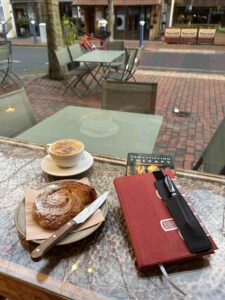Last week, I started to share some of the thoughts I have been brewing concerning my own journey of being and becoming a psychotherapist. This writing prompt has been in service not only of my current book project, but also as I gather momentum on a research paper I hope to submit this spring: one that has explored the lived experience of other humanistic practitioners who have trained in both counselling and psychotherapy. I am enjoying the opportunity to step back and think what it is exactly that I do in a room with clients each week, what it is I am teaching trainees of this craft, and specifically, how I frame what I am communicating to the counsellors and psychotherapists on the two distinct programmes.
After last week’s short introduction, today I am posting some of my experience of that training arc….
As I recount my training and consider the two phases of the counselling and psychotherapy courses, I admit to something of a blurring which might somewhat contradict a thesis that sees the activities as distinct. However, I imagine I am one of the (fortunate?) few who in their core training in the broader humanistic tradition immediately made a connection with a specific modality i.e. for me, Gestalt. Furthermore, I always knew I was signing up to the commitment of the full four years: in all honesty though, not because I wanted to be a ‘psychotherapist’, but because I wanted to do as much training as I could – my love of learning as well as a more ‘neurotic’ need to not leave home! Returning to the modality specialism, the ideas of Gestalt resonated with me immediately; and certainly, I was attracted with its clear model and methodology that didn’t leave behind the philosophy of the broader tradition. My practice and world view as a Buddhist meditator was also supported with the Gestalt’s emphasis phenomenology. Going back to my analogy earlier, in finding Gestalt I feel like I picked up and made a commitment to holding a particular blade. Others in my counselling course cohort struggled with its directivity and challenging nature. I relished it. And I think this is the first aspect of what distinguishing psychotherapy and counselling might include: there was something about adopting a methodology with a theory of mind and a model of ‘self’ to hold in the room as I meet a client: to understand the constraints and limits that mould our being-in-the-world.

This links to something I mention at the beginning of the book – the appreciation for a foundation in philosophy, and the refinement through theory. We might call this ‘theoretical formulation’: generating a model of what has played into the client’s presentation and the issue they have brought to the therapy. Relatedly, an advantage of moving into a specific modality earlier on for me also gave me a ‘theory of change’. I distinctly remember one way I carried over my interest in Gestalt between my counselling post graduate diploma and starting the Masters in psychotherapy was to start working with a Gestalt psychotherapist as supervisor. The way I presented clients in supervision shifted. I was holding ‘awareness’ and field theory more clearly as the lens through which I was seeing- and speaking-about- clients. The blade was cutting through to something more “cleanly”; something I can only word right now as becoming more ‘effective’ beyond a holding environment. I remember one course tutor remarking “we know you are a safe pair of hands…how do you now become effective?” I will say now, I don’t think this is just down to the modality – my own journey was one in Gestalt; and I encourage trainees now to clarify their frame through which they see the client, their distress, the work, and their role in facilitating it. We are seeing here flavours of that threefold structure of ontology, epistemology, through to the methodology: What is here (formulation), what can we know (theory of change), what can we put in place (methodology).
Whether we hold Rogers, the Perls, Berne, Mahrer (after Jung), or Gendlin we have theories of change processes (i.e. actualisation, integration, decontamination, individuation, symbolisation) through which we reach the wholeness offered by the humanistic tradition. During my Masters training, I was exposed to two lines of thinking that significantly impacted both how I saw change, and how I then facilitated such processes in the therapy room. One aspect was visiting more psychoanalytic literature; the other, meeting the ideas of system theory. On the first, while I still find my home in the wholeness view of the humanistic approach, visiting more completely psychoanalytic and psychodynamic theory opened me up to a model of change and wholeness that invites not just an acceptance toward less desirable self aspects / processes / parts but rather more radical than that. Through a radical opening (Todres, 2012) we come into deeper contact of all that we can be. I write in the book about (humanistic psychologist) Alvin Mahrer’s work: his ‘deeper potentials’ include the daimonic, the natural force in humans that can be constructive or destructive (May, 1969), manifesting in the anger, sexuality, aggression or murderous rage that the psychoanalytic tradition is much more comfortable and capable of speaking to. Radical opening leads to radical inclusion as our relationship to deeper potentials shifts. The second meeting of theory, the ideas of systemic family therapy added yet a further change in my ideas about change: namely distinguishing between first and second order change. Whilst first order change serves to restore the norm, second order change requires significant re-arrangement of our taken-for-granted world (Bott and Howard, 2012). This had me reflect on my own journey in therapy thus far, and seeing how the 4 years of therapy was allowing a process of deconstructing who I thought I was (in relation to the world I thought I had been a part of): a process holding a “going to pieces without falling apart” (Epstein, 1999). A number of writers and theorists speak to this. Caper (2020) for instance highlights how Bion talked about the difference between a therapy that is supportive and one that reveals a truth (which in the psychoanalytic tradition is the living with the discomfort of being, the pleasure and death principles). In our own tradition, Bugental (1987) also points to a type of therapy that merely advises and aides adjustment to life circumstances in contrast to the “something more” of his life changing, depth therapy. It’s interesting how Jung too draws our attention to “depth” psychology. Furthermore, when Spinelli (1994) draws our attention to “problems require solutions, while dilemmas can only be explored and lived with in a more or less satisfactory manner” (pg 36) there too is a sense that psychotherapy is not applying change but rather dancing with change and uncertainty itself.
 With a confidence growing from my own experiences in personal therapy, I started to try things out in the therapist chair too. I already had a theoretical grasp of experimentation from my Gestalt passion, but with encouragement from the systemic ideas, I started to see the worth of “interrupt and disrupt” and other strategic interventions (Bott and Howard, 2012). I remember sharing the delight with a client when assisting a breakthrough a pattern in their experiencing of IBS by (paradoxically) inviting them to “do” more of their symptom. There is a need to speak to a finesse in these ideas; one that addresses a “doing to” clients that is far from helpful. I will come back to ideas of first and second order change and introducing interventions more explicitly later. My intention now is to merely sow some seeds of theory harvested from my own counselling into psychotherapy transition.
With a confidence growing from my own experiences in personal therapy, I started to try things out in the therapist chair too. I already had a theoretical grasp of experimentation from my Gestalt passion, but with encouragement from the systemic ideas, I started to see the worth of “interrupt and disrupt” and other strategic interventions (Bott and Howard, 2012). I remember sharing the delight with a client when assisting a breakthrough a pattern in their experiencing of IBS by (paradoxically) inviting them to “do” more of their symptom. There is a need to speak to a finesse in these ideas; one that addresses a “doing to” clients that is far from helpful. I will come back to ideas of first and second order change and introducing interventions more explicitly later. My intention now is to merely sow some seeds of theory harvested from my own counselling into psychotherapy transition.

